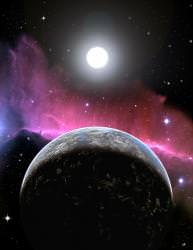 We live in a mind bogglingly big Universe filled with countless stars. We know intelligent life evolved here on Earth. It must be common across the Universe, right? But if there’s life out there, how come we haven’t been visited by aliens yet? Why haven’t we even picked up signals from alien television stations? Where’s all the life?
We live in a mind bogglingly big Universe filled with countless stars. We know intelligent life evolved here on Earth. It must be common across the Universe, right? But if there’s life out there, how come we haven’t been visited by aliens yet? Why haven’t we even picked up signals from alien television stations? Where’s all the life?
Continue reading “Podcast: The Fermi Paradox: Where are all the Aliens?”
Listening for ET
 Are we alone in the Universe? We won’t know until we really start looking for life around other stars… or listening for it.
Are we alone in the Universe? We won’t know until we really start looking for life around other stars… or listening for it.
Continue reading “Listening for ET”
Organic Material Found in an Ancient Meteorite
NASA researchers have discovered organic material inside a meteorite the recently fell in Canada’s Tagish Lake. The meteorite is especially valuable because scientists collected it shortly after it crashed in 2000, ensuring it wasn’t contaminated by local bacteria. The meteorite seems to contain many small hollow organic globules, which probably formed in the cold molecular cloud of gas and dust that gave birth to the Solar System. Meteorites like this have been falling to Earth for billions of years, and probably seeded the early planet with organic material.
Continue reading “Organic Material Found in an Ancient Meteorite”
How Did Early Bacteria Survive Poisonous Oxygen?
Oxygen makes up 21% of the Earth’s atmosphere, and we need it to breathe. But early organisms would have found this environment toxic. Ancient bacteria evolved protective enzymes that prevented oxygen from damaging their DNA, but what evolutionary incentive did they have to do this? Researchers have discovered that ultraviolet light hitting the surface of glacial ice can release molecular oxygen. Bacteria colonies living near this ice would have needed to evolve this protective defense. They were then well equipped to handle the growth of atmospheric oxygen produced by other bacteria that would normally be toxic.
Continue reading “How Did Early Bacteria Survive Poisonous Oxygen?”
The Early Earth’s Atmosphere was Similar to Titan
The thick organic haze that shrouds Titan is similar to what we had here on Earth billions of years ago; an environment that might have helped early life get a foothold. NASA researchers set up several experiments that reproduced the atmosphere in the early Earth and Titan today. The Earth experiments produced tremendous amounts of organic material, which could have been one of the ways life first appeared.
Continue reading “The Early Earth’s Atmosphere was Similar to Titan”
Bacteria Found Deep Underground
Princeton researchers have discovered a colony of bacteria that lives more than 3 km (2 miles) underground. This bacteria lives completely cut off from the biosphere on the surface of the Earth, and derives its energy from the radioactive decay of rocks underground. By finding life in these extreme conditions, scientists are expanding their understanding of what kinds of habits can support life.
Continue reading “Bacteria Found Deep Underground”
Hardy Microbes Might Be Happy on Mars
Is there life on Mars? If it’s there, it’s probably microscopic, and really tough; able to handle cold temperatures, low pressures, and very little water. A new class of microbes have been uncovered that seem to fit the bill. They’re able to survive and reproduce below the freezing temperature of water. These microbes expand the range of habitats that might support life in our Solar System, and will provide scientists with new characteristics to look for when exploring the Red Planet.
Continue reading “Hardy Microbes Might Be Happy on Mars”
Electrical Dust Storms Could Make Life on Mars Impossible
New research is suggesting that planet-wide dust storms on Mars could create a snow of corrosive chemicals toxic to life. These Martian storms generate a significant amount of static electricity, and could be capable of splitting carbon dioxide and water molecules apart. The elements could then reform into hydrogen peroxide molecules, and fall to the ground as a snow that would destroy organic molecules associated with life. This toxic chemical might be concentrated in the top layers of Martian soil, preventing life from surviving.
Continue reading “Electrical Dust Storms Could Make Life on Mars Impossible”
Squadrons of Planet Hunters Could Find Life
The Hubble Space Telescope demonstrated that the best viewing is outside the Earth’s atmosphere. Over the years, a series of new telescopes have been lofted into space, and expanded this view into other wavelengths: Spitzer, Chandra, Compton, etc. Next up is the James Webb Space Telescope, with a mirror 6 times larger than Hubble, due for launch in 2013. But these observatories will pale in comparison when squadrons of space telescopes reach orbit. Both NASA and ESA are working on next generation space-based interferometers. They could answer one of the most fundamental questions of science: is there other life in the Universe?
Continue reading “Squadrons of Planet Hunters Could Find Life”
Desert Varnish Might Be a Clue for Life on Mars
Rocks in the desert can form a shiny coating known to geologists as desert varnish. This varnish forms over thousands of years, and can maintain a record of the life around it by binding DNA, amino acids, and other organic compounds into a silica glaze. Geologists from Imperial College in London think that future rovers should be equipped with instruments that can analyze Martian rocks for the presence of past life in this desert varnish.
Continue reading “Desert Varnish Might Be a Clue for Life on Mars”
